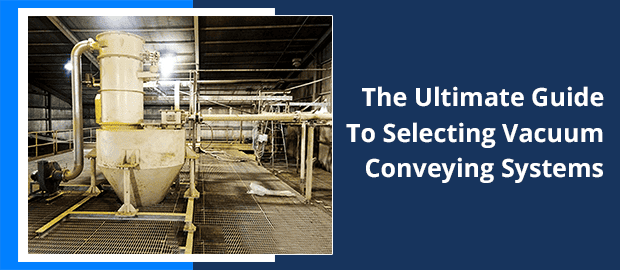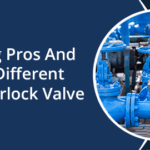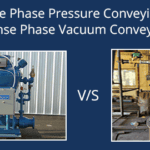The vacuum conveying systems act as suctioning machines. They use air pressure to move the materials through the enclosed pipeline. It is one of the popular pneumatic conveying systems manufacturer used for seamless applications.
These systems are ideal for larger applications connected to railcars, dusty containers, silos or bags for transporting materials. But what are the types of vacuum conveying systems, and how to choose one?
In order to understand the answer to these questions, here is a brief explanation of the types of vacuum conveying systems for powders and other materials. Once you have gone through the types, we can focus on the factors to consider while choosing a vacuum conveying system.
Transform Your Process with the Right Vacuum Conveying Solution
A] Types of Vacuum Conveying Systems
The vacuum conveying system is categorised into three types, which vary in functionality and components. The types of vacuum conveyors include:
1. Dilute Phase Vacuum Conveying Systems:
Dilute Phase Vacuum Conveying Systems employs a vacuum to transport materials through a pipeline. These systems utilise air streams at an optimal speed to carry the product. These systems have a low-pressure environment which helps to fluidize the material for efficient conveying.
When selecting vacuum conveying systems, it is important to consider the dilute phase option. However, it should be noted that this option is more suitable for materials that do not easily pack or compress under pressure.
Advantages:
- They can handle a wide range of materials, including powders, granules, and small particles.
- They are capable of achieving higher conveying rates, allowing for faster material transfer and increased productivity.
- The low-pressure environment in dilute phase conveying helps minimise product degradation, making it suitable for fragile or sensitive materials.
Disadvantages:
- Longer distances or higher elevations can lead to a decrease in conveying efficiency.
- Typically require higher energy consumption due to the use of higher air velocities and larger air volumes.
- A possibility of material separation occurring, where different components of the material may segregate based on size or density.
- Certain delicate or abrasive materials may still experience some level of degradation during conveying.
2. Dense Phase Vacuum Conveying Systems:
The advantage of vacuum conveying through the dense phase system is that it enables the equipment to use a vacuum, which gets controlled at minimised speeds. As a result, the movement of materials from one end to the other will be very slow within your system.
Such a lowered design of vacuum dense phase pneumatic conveying system is used for minimising the excessive stress that the products experience over time. Thus, this enables the fragile materials to move easily through the dense phase vacuum conveying systems without any damage.
Advantages:
- Reduces the strain on products being transported
- Prevents or repels the buildup within the tube
- Supports transportation of heavy materials
Disadvantages:
- The cost of investment is higher than the dilute phase system
- All of the bulk materials cannot be fluidised
3. Vacuum-Assisted Conveying Systems:
The vacuum-assisted belt conveyor will always be an option when you are looking for a conveying system with related technology. In this system, you won’t find any enclosed negative pressure in action.
Advantages:
- Used for moving the bulk cardboard boxes at ease
- Preferred to be used in assembly lines or elevators
- Designed for high flexibility
Disadvantages:
- Belts add difficulty for cleaning purposes
- Materials with adhesive will stick to the belt
Transform Your Process with the Right Vacuum Conveying Solution
B] Factors to Consider When Choosing a Vacuum Conveying System
The various types of vacuum conveying systems serve diverse applications in manufacturing and the industrial world. They make use of the blower while transporting materials in an industrial setup. The prime application of such systems is to move either small or large material types, including powdered grains or chemicals.
For moving the materials from one end to the other, the conveyors prefer utilising the pressure differences triggered by the vacuum. The materials will then be drawn towards a specific end, using negative pressure, from the inlet.
Among all compatible materials, the dry or bulk powders work most efficiently, as the conveyor’s airstream easily catches them. The loss of material is reduced, as all the possibilities of leaks are fixed within the inside sections of the system.
Depending on the industry, when choosing a vacuum conveying system, make sure you are considering all of the factors listed below:
1. Material characteristics:
You need to consider all of the characteristics associated with the material to be transported through the vacuum conveying system. Some of the things you should take note of are:
- Flow properties
- Particle size & shape
- Bulk density
- Chemical compatibility
- Combustible properties
- Particle distribution & attrition
Some or all of these characteristics can be influenced or be influencing agents to one another, as they are dynamic. Hence, it is better to run a proper analysis of the materials on priority.
2. Distance and rate of transfer:
The next thing you should consider is the distance feasibility that the vacuum conveying system offers you. The dilute phase is meant for short-distance material transportation, whereas the dense phase is meant for longer-distance and high-capacity transportation.
Therefore, depending on the distance you want your conveying system to cover, make your decision on the type that fits your specifications. Following that, you should also consider the transfer rate for added efficiency.
3. Environmental factors:
When choosing the vacuum conveying system, you cannot care to ignore environmental factors such as temperature, humidity, etc. Alongside the material characteristics, environmental hazards are also responsible for deteriorating the performance of a vacuum conveying system.
Consider the surroundings, and decide on the system that can withstand such risk measures around the operating site.
4. Cleanability and maintenance requirements
The efforts implemented for cleaning and maintaining the industrial systems are quite high. Therefore, while choosing a vacuum conveying system, looking for options that do not drain much of your operational time and effort is of utmost importance.
Some of the common maintenance issues that occur with conveyor systems are material spillage, blockages, belt spillage or mistracked conveyors. The construction of the conveyor systems should be solid to repel mechanical errors. And on the other hand, easy cleaning should be a priority to avoid longer downtime.
5. System flexibility and customization options
The vacuum conveyor system you choose should have the flexibility of running or transporting various types of dry products or materials. For instance, the conveying system should be capable of transporting potassium, lactose or penicillin.
In short, if you are dealing with transporting multiple types of materials, look for a system that can withstand the flow characteristic and density differences.
6. Equipment selection
All of the filters, blowers or valves you select should be environmentally friendly, have their warranties, must be validated by manufacturers for respective usage, and should last longer. Without the right equipment, your vacuum conveying system won’t have a great hold on the performance.
7. Piping and layout considerations
The layout considerations are quite important for choosing the right vacuum conveying system. It is because you will understand whether the system you chose is capable of transferring not just the bottle caps, tablets or candies but also the fine dust and nano-sized materials.
The piping and layout setup is what will help you determine if the equipment has the potential to safely handle a specific type of material. Thus, it will help the job of these machine operators easier, and the workplace conditions can be improved accordingly by using dedicated pipes or hoses.
8. System controls and automation
Alongside the vacuum pump, the system control panel is considered the brain of the entire equipment. The simplest of the functions within this system makes use of a micro PLC for controlling the operations, such as pulse, discharge or refill functions. Apart from that, even more complex PLC panels are equipped for batch weighing the high-end functionalities of the system.
So, you should note whether you are being provided with a modern-day control system. Make sure you are also getting the automation facilities to speed up the execution work. For instance, material handling functions are automated for transporting from pick-up to drop-off point without human intervention.
9. Safety features and compliance with regulations
There’s a serious safety issue across various industries that produce combustible dust as waste. Therefore, it is important to go with vacuum conveyors that have dust control mechanisms within to ensure these combustible wastes don’t create any problems. Some regulations, such as NFPA or OSHA, are strict upon approving only well-designed systems.
So, you need to check all of the safety features and determine if the compliance and regulation parameters are met for the product before buying it.
Transform Your Process with the Right Vacuum Conveying Solution
Conclusion
This was a brief overview of what factors to consider in the vacuum conveying system selection approach. All you need to do is get an optimal understanding of the functionality of each of them to filter out other quality aspects for deciding on the one you need. Take the help of a vacuum conveyor manufacturer who has been in the industry for a long time.
It will help you make faster decisions! Well, the trend of the vacuum-embedded conveying system is in high demand, considering industrial advances and commercial innovations. And this is expected to grow in the forthcoming years, which will give the industry great revenue within the next forecast period.



